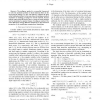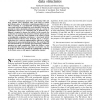1728 search results - page 27 / 346 » Self-Organisation: Paradigms and Applications |
CDC
2009
IEEE
14 years 1 months ago
2009
IEEE
— The nullspace method is a powerful framework to solve the synthesis problem of fault detection filters in the most general setting. It is also well suited to address the least...
VLSID
2004
IEEE
14 years 9 months ago
2004
IEEE
As chip complexity grows, design productivity boost is expected from reuse of large parts and blocks of previous designs with the design effort largely invested into the new parts...
IPPS
2010
IEEE
13 years 6 months ago
2010
IEEE
Contemporary processors are becoming wider and more parallel. Thus developers must work hard to extract performance gains. An alternative computing paradigm is to use FPGA technolo...
CCR
2011
13 years 7 days ago
2011
Scalability is said to be one of the major advantages brought by the cloud paradigm and, more specifically, the one that makes it different to an “advanced outsourcing” solu...
TCSV
2010
13 years 3 months ago
2010
Abstract--We present a novel tracking method for effectively tracking objects in structured environments. The tracking method finds applications in security surveillance, traffic m...


